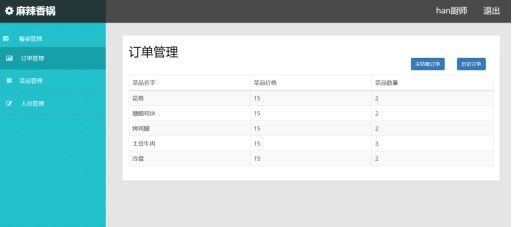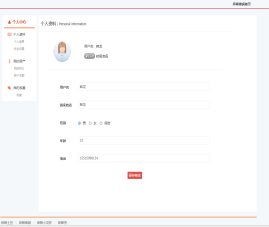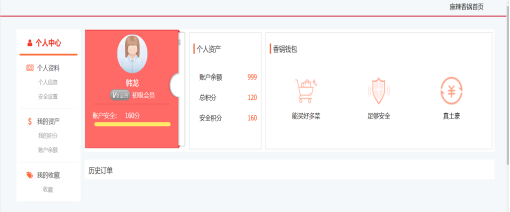基于SSM的餐饮管理系统的设计与实现
摘 要
该餐饮管理系统适用小型餐饮企业,此系统基于Java语言编写,系统实现工具使用Eclipse平台,数据库使用MySql数据库,前端界面设计与美化工具使用HBuilder。该系统网络结构使用B/S结构,项目管理工具使用Maven,系统框架使用SSM(Spring+SpringMVC+Mybatis)框架,便于系统的敏捷开发和代码的可扩展性。餐饮管理系统的实现遵循软件开发过程模型,分为可行性研究阶段、需求分析阶段、总体设计阶段、详细设计阶段、系统实现阶段、系统测试阶段。
系统分为前台用户界面和后台餐饮管理界面。前台用户界面核心功能点有菜品展示、个人中心、点餐单。后台餐饮管理的主要模块有餐桌管理、订单管理、菜品管理、人员管理等。该系统可以让餐饮行业工作效率提高,餐厅收益增加,实现餐饮运营信息化管理,提高了餐厅的综合竞争力。
关键词:Java;餐饮管理;SSM;MySql
Design and Implementation of a Catering Management System Based on SSM
Abstract
The catering management system is suitable for small catering enterprises. The system is based on Java language. The system is implemented by using Eclipse platform, database is MySql , design for front-end interface and beautification is to use HBuilder as tools .The network structure of the system uses B/S structure, the project management tool uses Maven, and the system framework uses SSM (Spring + Spring MVC + Mybatis) framework, which facilitates the agile development of the system and the extensibility of the code. The implementation of the catering management system follows the software development process model and is divided into the feasibility study phase, the requirements analysis phase, the overall design phase, the detailed design phase, the system implementation phase, and the system testing phase.The system is divided into the front-end user interface and the back-end catering management interface. The core function modules of the front-end user interface include dish display, personal center and order list. The main modules of backstage catering management include table management, order management, dishes management, personnel management, etc. The system can improve the efficiency of catering enterprise, increase the revenue of restaurants, realize the information management of catering operation, and improve the comprehensive competitiveness of restaurants.
Key words: Java; Catering Management ; SSM; MySql
目 录
前 言
第1章 概述
1.1 选题背景及意义
1.2 技术概述
1.2.1 JSP技术概述
1.2.2 Spring+SprngMVC介绍
1.2.3 MySQL数据库概述
1.2.4 Mybatis介绍
1.2.5 Maven介绍
1.3 开发平台介绍
1.3.1 Tomcat服务器
1.3.2 Eclipse简介
第2章 可行性研究
2.1 技术可行性
2.2 经济可行性
2.3 法律可行性
2.4 运行可行性
2.5 可行性研究结论
第3章 需求分析
3.1 用户需求描述
3.2用例模型
3.2.1 角色识别
3.2.2 用例识别
3.2.3 用例图
3.2.4 用例描述
3.3 概念模型
3.3.1 视图模型
3.6.2 逻辑模型
3.3.3 实体模型
3.4 实体-关系图
第4章 总体设计
4.1 设计目标
4.2 系统体系结构设计
4.2.1 体系结构概念
4.2.2 体系结构设计内容
4.3 系统功能设计
4.3.1 前台系统功能
4.3.2 后台系统功能
4.3.3 系统各功能模块功能描述:
4.4 模块结构设计
4.4.1 前台模块设计
4.4.2 后台模块设计
4.5 实体类设计
第5章 详细设计
5.1 系统文件组织结构
5.1.1 src/main/java文件夹
5.1.2 target文件夹
5.1.3 pom.xml文件
5.2 前台模块设计
5.2.1 用户登录
5.2.2 用户点餐
5.3 后台模块设计
5.4 数据库设计
5.4.1 数据库表结构详细设计
5.4.2 数据库连接详细设计
第6章 系统实现
6.1 前台界面系统实现
6.1.1 前台登陆
6.1.2 用户点餐
6.1.3 用户个人中心
6.2 后台界面系统实现
6.2.1 员工登录
6.2.2 菜品管理
6.2.3 餐桌管理
6.2.4 订单管理
结 论
致 谢
参考文献


















